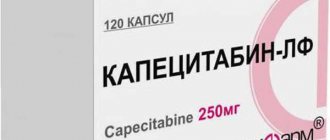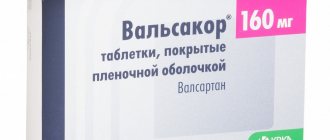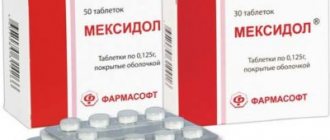Pharmacological properties of the drug Zinnat™
Pharmacodynamics . Cefuroxime axetil (cefuroxime 1-acetoaxetyl ester) is an oral form of the cephalosporin antibiotic cefuroxime. It is bactericidal, resistant to most β-lactamases, and active against a wide range of gram-positive and gram-negative microorganisms. The bactericidal effect of cefuroxime is due to inhibition of the synthesis of the cell membrane of microorganisms. Cefuroxime is highly active against the following microorganisms: gram-negative aerobes: Haemophilus influenzae (including ampicillin-resistant strains), Haemophilus parainfluenzae, Moraxella (Branhamella) catarrhalis, Neisseria gonorrhoeae (including penicillinase-producing and non-penicillinase-producing strains), Escherichia coli, Klebsiella spp ., Proteus mirabilis, Providencia spp., Proteus rettgeri; gram-positive aerobes: Staphylococcus aureus and Staphyloccocus epidermidis (including penicillinase-producing strains, but excluding methicillin-resistant strains), Streptococcus pyogenes (and other β-hemolytic streptococci), Streptococcus pneumoniae, group B Streptococcus (Streptococcus agalactiae); anaerobes: gram-positive and gram-negative cocci (including Peptococcus and Peptostreptococcus spp. ), gram-positive bacteria (including Clostridium ) and gram-negative bacteria (including Bacteroides and Fusobacterium spp.), Propionibacterium spp.; other microorganisms: Borrelia burgdorferi ; microorganisms resistant to cefuroxime: Clostridium difficile, Pseudomonas spp., Campylobacter spp., Acinetobacter calcoaceticus, Listeria monocytogenes , methicillin-resistant strains of Staphylococcus aureus and Staphylococcus epidermidis, Legionella spp. ; microorganisms, some strains of which are resistant to cefuroxime: Enterococcus (Streptococcus) faecalis, Morganella morganii, Proteus vulgaris, Enterobacter spp., Citrobacter spp., Serratia spp., Bacteroides fragilis. Pharmacokinetics . After oral administration of cefuroxime, axetil is absorbed in the intestine, hydrolyzed in its mucous membrane and enters the systemic circulation as cefuroxime. The optimal level of absorption is observed when taken immediately after a meal. The maximum concentration of cefuroxime in the blood plasma is observed approximately 2-3 hours after taking the drug. The half-life is approximately 1–1.5 hours. The degree of binding to plasma proteins is 33–55%, depending on the determination method. Cefuroxime is excreted unchanged by the kidneys by tubular secretion and glomerular filtration. Concomitant use of probenecid increases AUC by 50%. Plasma levels of cefuroxime decrease during dialysis.
Pharmacokinetics
After oral administration, Zinnat is absorbed from the digestive tract quite slowly (the process can be accelerated by parallel consumption of food). The highest concentration of the antibiotic in the blood is recorded after 2–3 hours from the moment of use of the medication.
The half-life of Zinnat averages about one and a half hours, excretion occurs through the kidneys.
The negative properties of the product include:
- penetration into breast milk;
- passage through the placenta.
The barrier separating the circulatory system and the central nervous system is overcome by the active substance of the drug quite quickly. This property allows Zinnat to be used as an antibiotic for the treatment of diseases affecting the spinal cord and brain.
Indications for use of the drug Zinnat™
Infections caused by microorganisms sensitive to the drug:
- ENT organs (otitis media, sinusitis, tonsillitis, pharyngitis);
- lower respiratory tract (pneumonia, acute bronchitis and exacerbation of chronic bronchitis);
- urinary system (pyelonephritis, cystitis and urethritis);
- skin and soft tissues (furunculosis, pyoderma and impetigo);
- gonorrhea, acute uncomplicated gonococcal urethritis and cervicitis;
- early manifestations of Lyme disease and subsequent prevention of late manifestations of Lyme disease in adults and children over the age of 12 years.
Contraindications in children
- It is important to understand that the presence of a serious allergy during pregnancy can cause an allergic reaction in the child. Therefore, the use of the drug is prohibited if you are intolerant to cephalosporin.
- It should be used with caution in the presence of diagnosed phenylketonuria, because aspartame is present in the suspension.
- Under strict supervision, treatment for diabetes mellitus is permitted, due to the presence of sucrose in the powder for dilution.
- For diseases of the digestive system, especially those aggravated by bleeding, the use is very limited.
You should also notify your doctor about the presence of anemia in a child in order to avoid worsening the condition.
Use of the drug Zinnat™
Usually the duration of treatment is 7 days (from 5 to 10 days). For better absorption, it is recommended to take the drug after meals. Adults: Most infections - 250 mg 2 times a day. Urinary tract infections - 125 mg 2 times a day. Moderate respiratory tract infections (bronchitis) - 250 mg 2 times a day. More severe respiratory tract infections (or suspected pneumonia) - 500 mg 2 times a day. Pyelonephritis - 250 mg 2 times a day. Uncomplicated gonorrhea - 1 g once. Lyme disease in adults and children over 12 years of age - 500 mg 2 times a day for 20 days. Cefuroxime is also available as a sodium salt (Zinacef) for parenteral use. This allows for sequential therapy with a single antibiotic when switching from the parenteral route to the oral route, if there is a clinical indication for this. Zinnat is effective in the sequential treatment of pneumonia and exacerbations of chronic bronchitis after previous parenteral use of Zinacef (cefuroxime sodium). Sequential therapy: Pneumonia: 1.5 g of Zinacef 2-3 times a day (IV or IM) for 48-72 hours, followed by Zinnat 500 mg 2 times a day orally for 7-10 days. Exacerbation of chronic bronchitis: 750 mg of Zinacef 2-3 times a day (IV or IM) for 48-72 hours, followed by the use of Zinnat 500 mg 2 times a day orally for 5-10 days. The duration of both parenteral and oral use of the drug is determined by the severity of the infection and the patient's condition. Children: In children aged 3 months to 2 years, the recommended dose is 125 mg (suspension - 10 mg/kg) 2 times a day for most infections (maximum daily dose 250 mg). For children over 2 years of age, with otitis media and more severe infections, the recommended dose is 250 mg (suspension - 15 mg/kg) 2 times a day (maximum daily dose - 500 mg). Recommendations for dosing the suspension in children depending on age and body weight are given in the table. 10 mg/kg for most infections
Age | Body weight (kg) | Dose (mg) 2 times a day | Number of measuring spoons (5 ml) |
| 3–6 months | 4–6 | 40–60 | 1/2 |
| 6 months–2 years | 6–12 | 60–120 | 1/2–1 |
| 2 years–12 years | 12–20 and more | 125 | 1 |
15 mg/kg for the treatment of otitis media and more severe infections
Age | Approximate body weight (kg) | Dose (mg) 2 times a day | Number of measuring spoons (5 ml) |
| 3–6 months | 4–6 | 60–90 | 1/2 |
| 6 months–2 years | 6–12 | 90–180 | 1–11/2 |
| 2 years–12 years | 12–20 and more | 180–250 | 11/2–2 |
Zinnat tablets cannot be broken, so it is recommended that young children be prescribed the drug in the form of a suspension. Preparation of the suspension
- Shake the bottle thoroughly to ensure the granules are friable. Remove the measuring cap, lid and protective membrane. If the membrane is damaged or missing, the drug is unsuitable for use.
- Pour 37 ml of water into the measuring cap (up to the mark on the cap) and add this water to the bottle, close the lid.
- Invert the bottle and shake vigorously (approximately 15 s).
- Return the bottle to its normal position and shake thoroughly.
If necessary, the suspension opened in reusable bottles can be further diluted with cold fruit juice or milk immediately before use. The dissolved suspension must not be mixed with hot liquids. Always shake the bottle thoroughly before use.
Additional Information
According to the instructions for Zinnat, the medicine should be stored at room temperature in a cool and dry place. Shelf life under recommended conditions is 24 months. The prepared Zinnat suspension should be stored only in the refrigerator, but no more than 10 days.
Prepare the suspension as follows: shake the contents of the bottle well. Using a measuring cup, measure 20 ml of water, pour it into the bottle, close the lid, then shake the container vigorously until the granules are completely dissolved. Then the bottle is returned to its original position and shaken well again.
Side effects of the drug Zinnat™
When using cefuroxime axetil, side effects are moderate and are mostly reversible. The following side effects are classified by organs and systems and by frequency of occurrence: very often (≥1/10); often (≥1/100 and ≤1/10); uncommon (≥1/1000 and ≤1/100); rare (≥1/10,000 and ≤1/1000); very rare (≤1/10,000). Infections and infestations Often - overgrowth of Candida . From the blood and lymphatic system Often - eosinophilia. Uncommon: positive Coombs test, thrombocytopenia, leukopenia (sometimes severe). Very rarely - hemolytic anemia. Cephalosporins as a class have the property of being absorbed on the surface of the red blood cell membrane and interacting with antibodies, which can lead to a positive Coombs test (impact on the determination of blood compatibility) and (very rarely) to hemolytic anemia. Immune system Hypersensitivity reactions, including: uncommon - skin rash; rarely - urticaria, itching; very rarely - drug fever, serum sickness, anaphylaxis. From the side of the central nervous system : Often - headache, dizziness. From the gastrointestinal tract Often - gastroenterological disorders, including diarrhea, nausea, abdominal pain. Uncommon: vomiting. Rarely - pseudomembranous colitis. From the hepatobiliary system Often - a transient increase in the level of liver enzymes (ALAT, AST, LDH). Very rarely - jaundice (mostly cholestatic), hepatitis. From the skin and subcutaneous tissues Very rarely - erythema multiforme, Stevens-Johnson syndrome, toxic epidermal necrolysis (exanthematous necrolysis).
Reviews and analogues
According to patient reviews, Zinnat does not always give a positive result without side effects. For many children, the medicine caused stomach pain and diarrhea.
Many sick children find it difficult to tolerate the use of the drug. However, Zinnat performed excellently in the treatment of otitis and sinusitis. According to parents, Zinnat copes well with upper respiratory tract infections in sick children, while simultaneously relieving them of the symptoms of illness.
In adult patients, side effects are rarely observed when the drug is used correctly. Most often it is a headache and mild nausea. Severe adverse reactions are extremely rare.
It should be noted that it is the incorrect use of antibiotics that leads to serious consequences. For example, taking the drug before meals or on an empty stomach will certainly cause side effects and pain in the gastrointestinal tract.
For many patients, taking the drug in liquid form causes allergies, which is associated with aromatic and food additives. This fact makes taking pills preferable.
According to patients and based on reviews of the drug Zinnat, the majority is inclined to believe that this is a real effective remedy for the treatment of severe infectious diseases.
But it is necessary to take into account the presence of other chronic or autoimmune diseases in order to avoid exacerbation or worsening of the condition.
There are a number of analogues of this antibiotic that have the same effect on infections of various organs.
Analogue drugs:
- Augmentin
- Cefriaxon
- Cefotaxime
- Cephalexin
- Aksetin
- Tzefat
- Cefaclor
- Ketoceph
- Proxim
- Antibioxime
- Spizeph
All of these are drugs from a series of second-generation cephalosporins that have the same effect on infections. But in any case, these are antibiotic agents, the use of which is possible only on the recommendation of a specialist.
Special instructions for the use of Zinnat™
The drug is prescribed with extreme caution to patients with a history of allergic reactions to penicillins or other β-lactam antibiotics. The use of cefuroxime axetil (as well as other antibiotics) can lead to overgrowth of Candida . Long-term use may also lead to overgrowth of other nonsusceptible microorganisms (eg, Enterococci, Clostridium difficile ), which may require discontinuation of treatment. When using broad-spectrum antibiotics, pseudomembranous colitis may develop. This should be taken into account if patients experience severe diarrhea during or after treatment. The composition of the drug in the form of a suspension includes sucrose, which must be taken into account when prescribing the drug to patients with diabetes mellitus. The suspension also contains aspartame, which is a source of phenylalanine, so this form of the drug is used with caution to treat patients with phenylketonuria. During treatment with Zinnat in patients with Lyme disease, the development of the Yarisch-Gersheimer reaction is possible. This reaction occurred directly as a result of the bactericidal effect of Zinnat on the microorganism that causes Lyme disease, the spirochete Borrelia burgdorferi. It is necessary to explain to patients that this is a common consequence of antibiotic therapy for Lyme disease and does not require special therapy. When carrying out sequential therapy, the time of transition from parenteral administration of the drug to oral administration is determined by the severity of the infection, the clinical condition of the patient and the sensitivity of the infectious agent. If there is no clinical improvement within 72 hours, parenteral therapy should be continued. During pregnancy and breastfeeding . There is no experimental data on the embryotoxic or teratogenic effects of cefuroxime axetil, but it should be prescribed with caution in the first months of pregnancy. Cefuroxime is excreted in breast milk, so the drug is used with caution during breastfeeding. Children . There is no experience with the use of Zinnat for the treatment of children under 3 months of age. Impact on the ability to drive vehicles and operate machinery . Since the drug may cause dizziness, the patient should be warned that driving vehicles and operating machinery should be done with caution.
Zinnat: release forms
The drug Zinnat has 2 release forms:
- Pills
- Granular Powder
The tablets are coated. These are tablets in the form of capsules, oval in shape, white. Since the dose of the active substance is different, the tablets are engraved “GXES5” for 125 milligrams and “GXES7” for 250 milligrams. The package contains blisters of 5 or 10 pieces.
Excipients of Zinnat tablets are:
- Microcrystalline cellulose
- Various sodium salts
- Vegetable oil
- Propylene glycol
- Silica
- Benzonates
- Dye white
In the production of granules for the preparation of Zinnat suspension with the active substance - 125 milligrams of cefuroxime, the following are additionally used:
- Sucrose
- Stearic acid
- Acesulfame potassium
- Aspartame
- Gum
- Purified water
- Tutti-frutti flavor
Granules of the drug are grains of different shapes and sizes (up to 3 millimeters in diameter). It has a bright fruity aroma, and when diluted with water it turns into an almost white suspension with a sweet taste and pleasant aroma.
Usually the drug is prescribed to children in the form of granules, since it is difficult for them to take the medicine in tablets.
Drug interactions Zinnat™
Drugs that reduce gastric acidity may reduce the bioavailability of Zinnat and minimize the effect of accelerating absorption after meals. Like other antibiotics, Zinnat can affect intestinal flora, which leads to decreased estrogen reabsorption and decreased effectiveness of combined oral contraceptives. Since the ferrocyanide test may produce a false-positive result, it is recommended to use the glucose oxidase or hexokinase technique to determine blood glucose levels in patients receiving cefuroxime sodium therapy. Cefuroxime does not affect the results of the alkaline picrate method for determining creatinine levels.
Antibiotics: how to choose correctly?
Not every cold can be treated with antibiotics. This is what needs to be taken into account. A “cold” does not always have a viral or bacterial origin.
If the cold gets worse and gives complications to different organs, then you cannot do without the use of antibiotics. But you cannot resort to self-medication. Only a specialist doctor can prescribe the correct treatment by selecting the right drug.
If there is no improvement within 4-5 days from the onset of the disease, this means that a bacterial-viral infection is present. You need to see a doctor to prescribe the necessary medications. It is antibiotics that can stop the development of the disease, preventing possible complications.
Complications after a cold:
- Pneumonia
- Sinusitis
- Inflammation of the lymph nodes
- Sinusitis
- Purulent tonsillitis and other ailments
When choosing a drug, you need to rely on various arguments.
For scarlet fever
This infectious disease is caused by a type of streptococcus, and its standard treatment is penicillin or cephalosporin antibiotics. Zinnat and Augmentin are the most commonly used; The therapeutic course at home is 10 days.
The idea is to limit the conditions of complications - it is known that scarlet fever, if insufficiently treated, can cause early complications of otitis media, inflammation of the lymph nodes and arthritis. Late complications of scarlet fever include kidney inflammation, rheumatoid arthritis, hepatitis, and myocarditis. The treatment parameters for Zinnat for scarlet fever are determined exclusively by the attending physician and are correctly followed.
For pneumonia
The profile of the causative agent of pneumonia is similar to that of bronchitis. However, the situation is much more complicated, since the visible infection covers an important organ after inflammation has already begun, for example, in the throat or bronchi. The immune defense is weakened, and it is logical that the disease is attacked by strong drugs such as antibiotics.
A wide spectrum is used - for example, Zinnat, usually the course of treatment with it lasts 7-10 days. When treating pneumonia in a hospital, monotherapy with one antibiotic or combined therapy is practiced, with the participation of two or even three antibiotics, taking into account the type of pathogenic microorganisms.
Other drugs are also prescribed to make coughing and breathing easier; B vitamins and probiotics. The idea behind antibiotic treatment is both to block pathogens and to address the immune response to such new events.
For sore throat
As you know, a sore throat can be felt in several different diseases. They may be part of the symptoms of a cold or viral illness. We may have a sore throat with sore throat, with pharyngitis, sore throat is common with scarlet fever and bronchitis. Whether you need to take Zinnat or another antibiotic depends on the diagnosis. It is for this reason that the doctor must resolve this issue.
For example, not every sore throat needs an antibiotic - but with a purulent one, this is the rule. Basically, an antibiotic is administered when the causative agent of the inflammatory process is bacterial. The type of bacteria that is detected during microbiological examination of secretions determines whether Zinnat is an appropriate antibiotic. In general, this antibiotic is effective against a wide range of bacterial strains.
In practice, there are cases when treatment with a broad-spectrum antibiotic Zinnat is urgently started until the results of a microbiological study are determined. If necessary, the medication is replaced.




